
Sisyrinchium bellum, the western blue-eyed grass or Californian blue-eyed grass, is the common blue-eyed grass of California and Oregon in and west of the Sierra Nevada, its range extending south into Baja California. In parts of its range, western blue-eyed grass has previously been classified as Sisyrinchium eastwoodiae, S. greenei and S. hesperium, but these names are now considered synonyms.
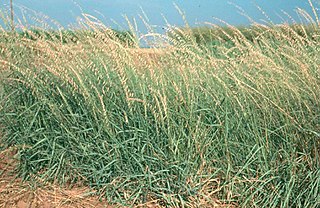
Bouteloua curtipendula, commonly known as sideoats grama, is a perennial, short prairie grass that is native throughout the temperate and tropical Western Hemisphere, from Canada south to Argentina.

Olsynium douglasii is a species of flowering plant in the iris family (Iridaceae). Common names include Douglas' olsynium, Douglas' grasswidow, grass-widow, blue-eyed grass, purple-eyed-grass, and satin flower, It is the only species in the genus Olsynium in North America, the remaining 11 species being from South America. It was formerly treated in the related genus Sisyrinchium. Despite the common names, it is not a true grass (Poaceae).

Symphyotrichum laeve is a flowering plant native to Canada, the United States, and Coahuila (Mexico). It has the common names of smooth blue aster, smooth aster, smooth-leaved aster, glaucous Michaelmas-daisy and glaucous aster.

Stellaria graminea is a species of flowering plant in the family Caryophyllaceae known by the common names common starwort, grass-leaved stitchwort, lesser stitchwort and grass-like starwort.

Sambucus racemosa is a species of elderberry known by the common names red elderberry and red-berried elder.
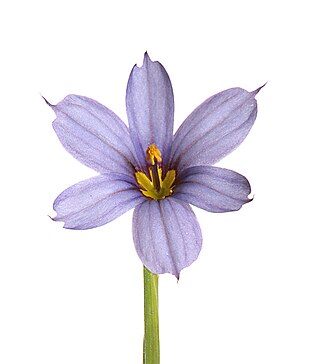
Sisyrinchium angustifolium, commonly known as narrow-leaf blue-eyed-grass, is a herbaceous perennial growing from rhizomes, native to moist meadow and open woodland. It is the most common blue-eyed grass of the eastern United States, and is also cultivated as an ornamental.

Sisyrinchium idahoense, the Idaho blue-eyed grass, is a perennial that is native to western North America. It is not a true grass, but is instead in the family Iridaceae.
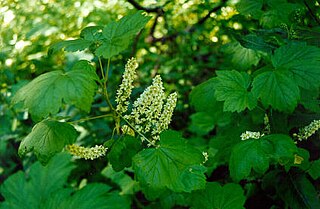
Ribes hudsonianum is a North American species of currant, known by the common name northern black currant.

Sisyrinchium californicum is a species of flowering plant in the iris family known by the common names golden blue-eyed grass, yellow-eyed-grass, and golden-eyed-grass. It is native to the west coast of North America from British Columbia to central California, where it grows in moist habitat, often in coastal areas.
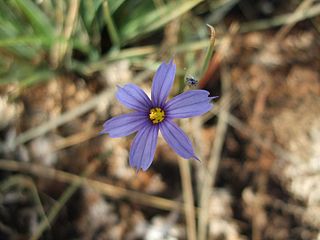
Sisyrinchium funereum is an uncommon species of flowering plant in the family Iridaceae known by the common names Funeral Mountain blue-eyed grass and Death Valley blue-eyed-grass. It is endemic to the Mojave Desert of the United States, where it is known only from the Funeral Mountains and Death Valley area in eastern California, and the Ash Meadows area just over the border in Nevada. It grows in wet, highly alkaline habitat, such as seeps and mineral springs.
Sisyrinchium halophilum is a species of flowering plant in the family Iridaceae known by the common name Nevada blue-eyed grass. It is native to the western United States in and around the Great Basin and Mojave Desert, where it grows in moist, often highly alkaline habitat, such as seeps, meadows, and mineral springs.

Oenothera macrocarpa, the bigfruit evening primrose, Ozark sundrops, Missouri evening primrose, or Missouri primrose, is a species of flowering plant in the evening primrose family Onagraceae, native to northeast Mexico and the south-central United States, where it is found in calcareous prairies and limestone outcrops.

Sisyrinchium dichotomum is a rare species of flowering plant in the iris family known by the common names wishbone blue-eyed grass, white irisette, and reflexed blue-eyed grass. It is native to North Carolina and South Carolina in the United States, where fewer than ten populations remain in four counties. It is threatened by the loss and degradation of its habitat and is a federally listed endangered species of the United States.
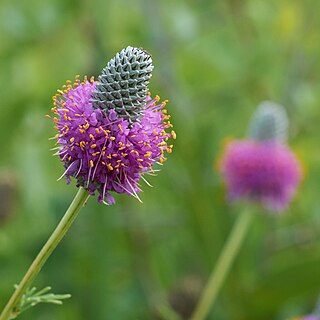
Dalea purpurea is a species of flowering plant in the legume family known as purple prairie clover. Native to central North America, purple prairie clover is a relatively common member of the Great Plains and prairie ecosystems. It blooms in the summer with dense spikes of bright purple flowers that attract many species of insects.
Sisyrinchium sarmentosum is a species of flowering plant in the iris family known by the common names mountain blue-eyed grass and pale blue-eyed-grass. It is native to the Pacific Northwest of North America, where it is known from a part of the Cascade Mountains in Washington and Oregon.
Sisyrinchium longipes, called the timberland blue-eyed grass, is a small herb native to Arizona, California and Chihuahua. It is an erect perennial up to 50 cm tall, with yellow to orange flowers, very often with prominent brown veins. It generally occurs in moist meadows, streambanks or pools in coniferous woods.

Sisyrinchium septentrionale, the northern blue-eyed grass, is a plant species native to western North America. It has been known from Canada, and 4 counties in the US State of Washington and 2 in Montana.

Sisyrinchium albidum, commonly known as white blue-eyed grass, is a species of flowering plant in the family Iridaceae.




















